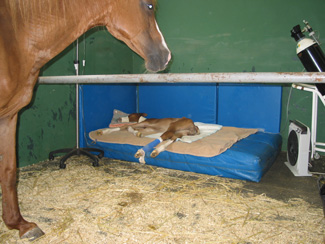Early detection of septicemia in neonate foals

Neonate foals frequently suffer a bacterial infection of the blood known as septicemia, which is usually detected when it has fatal consequences for the animals. After a complete study, the authors of this work have determined the usefulness of some protein fragments, known as D-dimers, for the early detection of this disease.
Septicemia is a bacterial infection of the blood. Neonate foals (horse babies less than 21 days-old) suffer from this disease quite often, causing economic losses to the breeders due to medication costs and associated mortality. Foals get infected while in the uterus of the mare or during the first hours or days of life. Infection enters through the belly stump, bowel wall, lungs or wounds, may reach the blood (septicemia) and travels to other part of the body system.
Septicemia produces severe different alterations in the organism and has also a detrimental effect on hemostatic system, which is the responsible of preventing hemorrhages and thrombosis. When this system fails it is known as Disseminated Intravascular Coagulation (DIC). Clinical signs appear late in the course of the disease and use to be fatal (spontaneous bleeding, thrombosis and shock).
Several blood parameters are available for the early detection of DIC before clinical signs appear. One of them is D-dimer concentration, which is a fibrin clot destruction product, and have demonstrated to be very useful for the detection of pre-DIC status in human beings and dogs.
Our hypothesis was that septic foals had increased D-dimer blood concentrations and that D-dimer concentrations will be related to diagnosis of septicemia, DIC and outcome.
For this study, all the foals referred to the Equine Internal Medicine Service of the Veterinary Teaching Hospital of the UAB during a period of 1.5 years were used. Blood samples at different moments of the hospitalization were taken and several hemostatic parameters were determined.
Image 1. Image of an inmuno-turbidimeter, one of the instruments used to mesure D-dimers concentration in the foals studied.
The study concluded that 50% of the septic foals were in a DIC status without observable clinical signs. D-dimer serum concentrations were significantly increased in septic foals compared to non-septic sick foals and healthy normal foals. D-dimer concentrations were significantly related to septicemia. This is a useful clinical information to confirm or rule out the diagnosis of septicemia and for the design of an specific treatment.
References
"Plasma D-dimer concentration in sick newborn foals". Armengou, L.; Monreal, L.; Tarancon, I.; Navarro, M.; Rios, J.; Segura, D. JOURNAL OF VETERINARY INTERNAL MEDICINE, 22 (2): 411-417 MAR-APR 2008.


